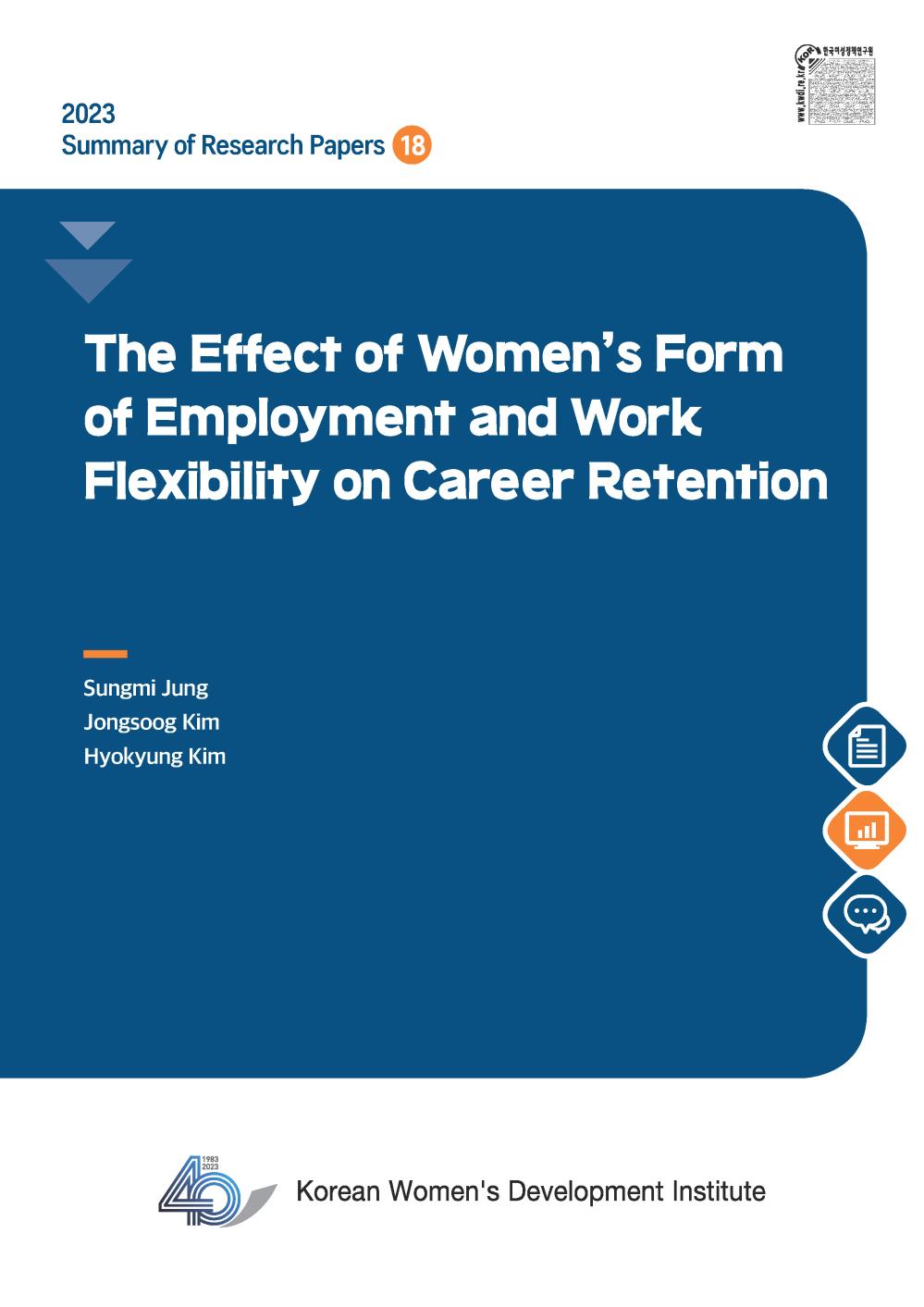Report
| The Effect of Women’s Form of Employment and Work Flexibility on Career Retention | |||
|---|---|---|---|
| Type | Basic | Period | 2023 |
| Manager | Sungmi Jung | Date | 2023-12-29 |
| Fiie | 18_여성의 취업형태 및 근무유연성이 경력유지에 미치는 영향.pdf ( 1.43 MB ) | ||
|
Abstract The Effect of Women’s Form of Employment and Work Flexibility on Career Retention Sungmi Jung Jongsoog Kim Hyokyung Kim
In this study, we examine how form of employment and work flexibility among women of childbearing / childrearing age can impact their career retention. The purpose is to move beyond the conventional focus that studies of women’s labor and career interruption had on whether they were re-employed or not, and to provide policy implications conducive toward bolstering employment rates via career retention and closing gaps in working conditions, thus ultimately contributing to policies in support of women’s career development.
Although Korea in recent years has seen a steady rise in women’s employment rates, as well as an alleviation of the so-called ‘M curve’ phenomenon, comparisons with key developed economies show that women’s employment rates in Korea remain relatively lower. This is mainly attributable to the low employment rate among a core age group - namely women with young children. The recent rise in unmarried and childless women has led to a quick drop in women’s career interruption. However, career interruption remains an on-going issue for women with young children. Thus, there is a need to focus policy efforts on women with children.
Looking at various categories of outcomes regarding career retention among women throughout an 11-year window(2 years before childbirth ~ 8 years following childbirth), we found that women who experienced childbirth fell into a total of 6 categories of labor market outcomes. Factors such as additional childbirth, university or higher diploma, spouse’s income, availability of family / public care were found to be key determinants of these outcomes. In particular, higher spousal income was found to have an added worker effect in that it lowered the probability of various types of outcomes.
Notably, factors such as university or higher diploma, family care, and additional childbirth were found to drive career interruptions among women who belonged to regular permanent positions prior to childbirth, whereas factors such as university or higher diploma, family / public support were found to drive career retention. While family care(i.e., in-home care) played a role in both outcome types, factors such as additional childbirth and the availability of public care were found to have contrasting effects. In particular, in the outcome type where women were able to retain a regular permanent position, the availability of public care was found to be decisive. Controlling for workplace characteristics prior to childbirth, our analysis found that the availability of parental leave and public care were key factors behind successful retention of regular permanent jobs. Meanwhile, in cases where regular permanent employment was discontinued following childbirth, the availability of parental leave was not found to have a significant impact. In the outcome type where women with primary school-age children re-entered the labor market into stable positions, the availability of public car was found to play a key role. Summarizing these findings, we can point to the availability of public care as a fundamental factor that is needed for women’s career retention. Furthermore, we found that a multi-layered support scheme encompassing in-home care, public care systems(public care, workplace care, ‘Idolbom’ Services, etc.) will be necessary for women to retain their labor market careers in a stable manner. Operating each program in a fragmented manner would be detrimental to career retention.
Looking also at how work hours affected career retention, our findings were in line with previous analysis results. Availability of public care played a role in the outcome type where 15~29 hour positions were retained while the availability of parental leave and public care drove the outcome type where women re-entered positions working 40 hours or less. Thus, public childcare facilities such as national / public childcare centers, workplace childcare centers, and ‘Idolbom’ Services were found to be very positively associated with the retention of positions working 15~40 hours. In particular, jobs offering parental leave could enable re-entry into positions working 30~40 hours. In all, we found the need for flexible work hours in addition to a stable 3-layered support structure: family care, public care system (public care, workplace care, and ‘Idolbom’ Services), and parental leave.
Numerous studies have looked at the individual impacts of parental leave or public care services on women’s career retention. By taking account of family care, public care, and social care(parental leave) simultaneously, this study is significant in that it looked at how these factors affected outcome types in terms of career retention. As stated previously, operating support schemes in a fragmented manner will do little to help career retention. This study shows that a multi-layered support system must also be provided for stable career retention - a finding that holds significant implications for informing the direction of future policies in support of women with children.
Research areas: Work?life Balance, Labor?Employment Keywords: Career Retention, Work Flexibility |
|||
